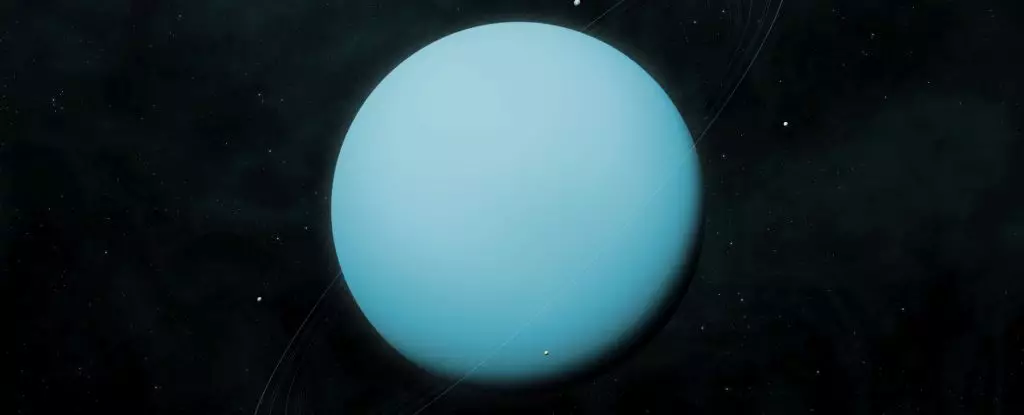For decades, Uranus remained an enigma among the giants of our Solar System. Unlike its counterparts—Jupiter, Saturn, and Neptune—whose internal heat emissions are well-documented, Uranus seemed to defy expectations. The Voyager 2 flyby in 1986 deepened this mystery: initial measurements suggested that Uranus did not emit more heat than it absorbed from the Sun. This anomaly sparked speculation and debate for years, questioning whether Uranus was a fundamentally different kind of planet. Recent scientific advancements, however, have turned this longstanding assumption on its head, revealing that the cold, distant ice giant is indeed giving off more heat than previously thought—a discovery that carries profound implications for planetary science.
The recent analysis, conducted independently by two scientific teams, offers a compelling correction to the earlier narrative. With refined tools and a broader dataset spanning decades, researchers now confirm that Uranus emits approximately 12.5% more heat than it receives from solar radiation. This subtle yet significant surplus betrays a planet still gradually cooling from its formation—an ongoing process that tells us much about its internal structure and history. Such a finding aligns Uranus more closely with Jupiter, Saturn, and Neptune, all of which radiate excess heat, serving as clues to the processes shaping their interiors and evolution.
The Significance of Internal Heat in Planetary Evolution
Understanding the internal heat flow of planets reveals crucial insights into their past and present states. When planetary scientists first studied Uranus, they expected it to be nearly thermally inert—an idea that seemed consistent given its frigid appearance and the initial Voyager data. However, the new findings suggest that Uranus isn’t as simple as a frozen remnant of formation. Instead, it continues to lose residual heat, indicating a dynamic internal environment that has persisted over eons.
This ongoing heat emission implies that Uranus’s interior may be more complex than previously assumed. It raises questions about the planet’s internal layering, the presence of radioactive elements, or even the existence of heat-generating processes not yet fully understood. The fact that Uranus emits a modest excess of heat, yet much less than Neptune or Jupiter, hints at differences in composition, formation, or thermal evolution—pushing scientists to reconsider models that have long defined this ice giant as an anomalously cold planet.
Moreover, this discovery realigns our understanding of planetary heat budgets in the outer Solar System. With Neptune emitting 162% more heat than it receives, and Jupiter at a staggering 113%, Uranus’s 12.5% excess offers a unique case study. Why is Uranus so comparatively subdued in its heat emission? Is it due to a distinctive internal structure, perhaps featuring a different distribution of heat-producing materials, or a history marked by colossal impacts that dissipated its internal energy? These are questions that challenge existing theories and point toward a need for deeper exploration.
The Broader Implications and Future Quest for Knowledge
The implications of this revelation extend beyond Uranus itself. It prompts a reevaluation of planetary formation theories, especially in terms of how ice giants develop and evolve over time. Understanding the internal processes that govern heat emission could transform our grasp of planetary system development—both in our Solar System and in exoplanetary systems orbiting distant stars.
The findings also bolster the case for returning to Uranus with dedicated missions. The planet’s subtle thermal emissions, previously overlooked or misunderstood, represent a missing piece in the puzzle of solar system formation. A future flagship mission to Uranus could deploy advanced instrumentation to probe beneath its cloudy atmosphere, unravel its internal structure, and directly measure its heat flux with precision. Such a mission would dramatically enhance our knowledge, potentially revealing unique internal processes or structural differences that set Uranus apart from its giant sibling, Neptune.
In my view, recent discoveries underscore the importance of reevaluating longstanding theories with new data and refined techniques. They remind us that even the coldest, most distant planets harbor secrets waiting to be uncovered—secrets that could challenge our entire understanding of planetary science. Uranus is no longer just a cold, mysterious obstacle in our solar neighborhood; it’s a dynamic world with a story to tell. Unlocking its thermal secrets promises to expand not only our knowledge of the solar system but also the fundamental processes that form and shape planets across the universe.

